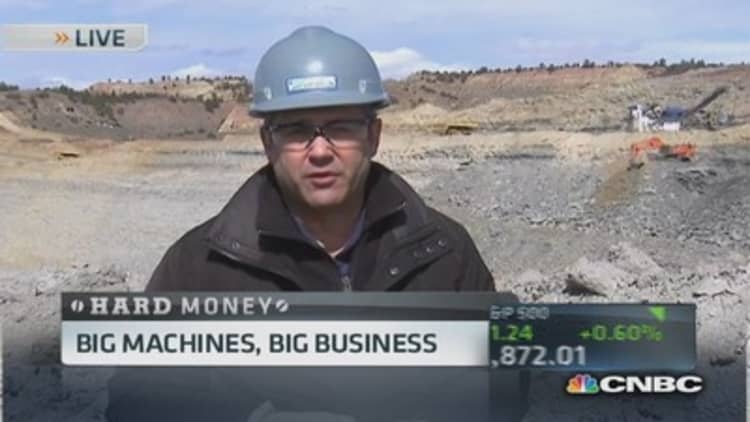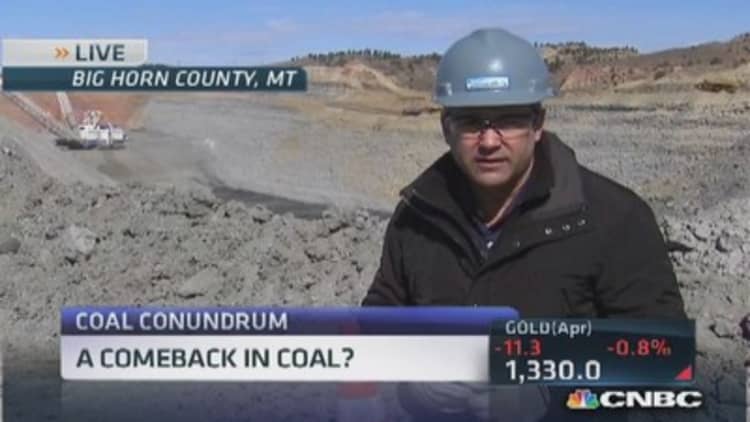
The first thing you notice at the Spring Creek mine in Decker, Mont., is the size. It's not just the sprawling, 9,000 acre site in Big Sky Country near the Montana-Wyoming line. It's everything about mining the coal.
Giant coal hauling trucks the size of two-story buildings zip around the complex with surprising ease, considering the fact that they are carrying 255 tons of coal per trip. The coal is loaded onto mile-long trains—each car carrying more than 100 tons—that leave the mine 24 hours a day, seven days a week, 365 days a year.
At the same time, massive 13,000-ton cranes known as draglines slowly peel back strips of earth and rock 200 feet deep to reveal the rich, black, 80-foot seam of coal below. As the coal is removed, giant machines are filling the strip back in, then moving over like a gigantic lawn mower and starting the process all over again.
Despite the dizzying amount of activity at Spring Creek, production is well below its prerecession peak. The sluggish economy and an abundance of cheap natural gas have hurt demand. So has the prospect of tougher environmental regulations following the spill of 30,000 tons of toxic coal ash in North Carolina in February and a proposal by the Obama administration for tougher limits on carbon emissions.
CORRECTION: The video embedded with this story originally misidentified the name of a Wyoming-based company. The correct name is L&H Industrial.
Cloud Peak CEO on 'tremendous' demand
But the Spring Creek mine's owner, Wyoming-based Cloud Peak Energy, believes coal is poised for a comeback. The U.S. Energy Information Administration, or EIA, sees a long-term horizon for coal.
"Even the EIA projects that 40 percent of America's electricity in the future, in 2030, is going to come from coal," Cloud Peak CEO Colin Marshall told CNBC Thursday. "Internationally, the demand is tremendous," Marshall said.
The economics of coal are changing, proponents say, particularly for the cleaner, lower-sulfur coal mined in the Powder River Basin of Wyoming and Montana. Natural gas prices are rising, making coal competitive again. Economies around the world are rebounding. And a record cold winter in most of the U.S. doesn't hurt either.
"There's nothing like a cold winter to remind utilities of the value of their coal fleet," said Paul Forward, managing director with Stifel Financial.

It is not as if coal ever vanished from the scene—far from it. The EIA says coal remains the largest source of fuel for U.S. power plants. Through the first 11 months of 2013, the most recent data available, coal accounted for about 39 percent of the 3.7 trillion kilowatt hours of electricity generated in the country.
Natural gas accounted for about 31 percent of the total electricity output. Solar and wind combined for just 4 percent.
But less than a decade ago, coal was far more dominant, responsible for more than half of U.S. electricity. A glut of natural gas changed that, and two years ago miners drastically cut production, shutting down more than a quarter of all active mines.
Coal companies' stock prices plunged along with production. Peabody Energy—the world's largest pure coal play—saw its shares fall from $72 to $15. Many were predicting the death of coal.
Polar vortex effect
Cue the polar vortex. The cold blast of arctic air that had settled over much of the country this winter sent power companies into overdrive. Natural gas prices spiked—up 24 percent over the past six months—pushing many utilities to burn less expensive coal instead. Then the weather stayed cold, and many plants burned through their coal reserves to meet the surge in electricity demand.
With spring here and the peak power demand of air conditioning season approaching, coal is more competitive with natural gas than it has been in years. The EIA last week projected the cost of natural gas to average $4.44 per million Btu in 2014. Coal, meanwhile, is projected to average just $2.36 per million Btu, though Powder River Basin coal loses much of that cost advantage because it doesn't burn as hot as higher-sulfur coal from the Eastern U.S.
And while many utilities are shutting down coal-fired power plants in the face of tougher regulations, Stifel Financial's Forward nonetheless thinks coal companies are in their sweetest spot in years.
"The trajectory of coal inventories has been surprisingly lower, and that sets up the possibility of several months of concern that those stockpiles might go even lower in a period of high natural gas prices," Forward said. "Things that can drive coal prices higher; like energy inflation, shortages of natural gas, bad weather, that sort of thing—they can hurt the rest of the economy, but can be a spur for long dormant coal prices."
Forward says that means coal mining stocks are worth a look.
"After two years of steep production cuts in coal, there's really not enough capacity to meet demand in a surging environment like we've seen," Forward said. "Cloud Peak Energy in the West, Peabody in the West, Consol in the East; these are firms with scale that are attractive to investors."

Seeking overseas demand
The long-term view is less clear.
Calling power plants "the largest concentrated source of (greenhouse gas) emissions in the United States," the Environmental Protection Agency in September proposed steep reductions in carbon emissions for new power plants. While the rules are still in the comment stage, they have already effectively halted plans for any new plants.
That has U.S. coal companies looking overseas—particularly in Asia—for demand. But port capacity in the Pacific Northwest is limited, and proposals for a new port as well as the added rail traffic to get the coal there are deeply controversial.
For now, coal companies are riding the wave, and mines like Spring Creek are going full tilt.
King Coal, it seems, is back. But no one is quite sure for how long.
—By CNBC's Scott Cohn and Brad Quick. Follow them on Twitter @ScottCohnCNBC and @bquick83.


